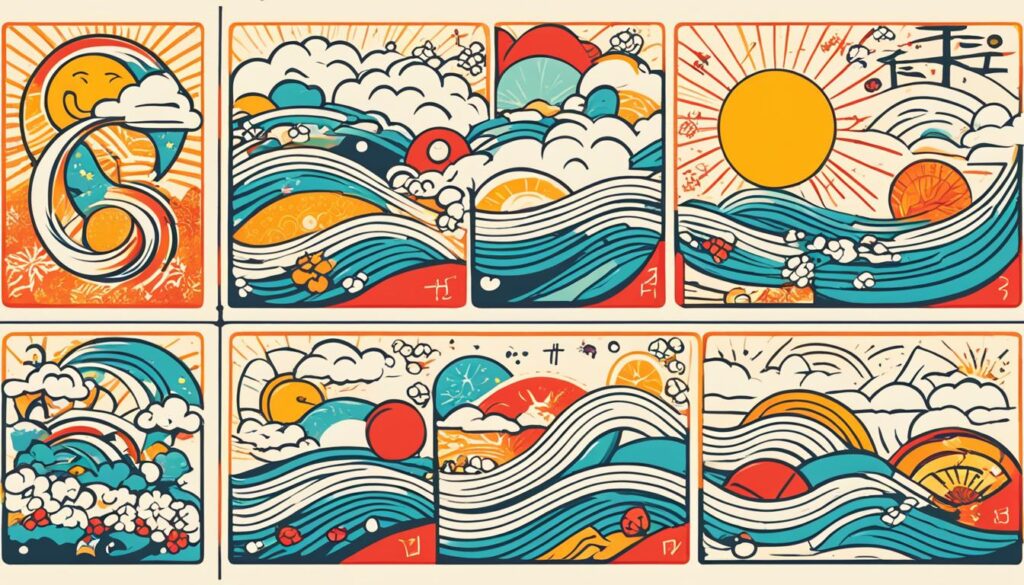In this article, you will learn how to say Tuesday in Japanese, including its meaning, grammar, pronunciation, and cultural usage. Knowing how to express the days of the week in Japanese can be useful for conversations, making plans, and understanding Japanese culture. So let’s dive in and explore how to say Tuesday in Japanese!
Tuesday is called “Kayoubi” in Japanese, written as 火曜日 in kanji characters. The first kanji character 火 means “fire,” symbolizing the energy and passion associated with Tuesday. It’s an interesting word to learn if you want to express the days of the week accurately in Japanese.
In terms of grammar, when using Tuesday in a sentence, you need to add the particle “に” (ni) after the day to indicate time. For example, to say “I have a meeting on Tuesday,” you would say “火曜日に会議があります” (Kayoubi ni kaigi ga arimasu).
To pronounce “Kayoubi,” start with the sound “kah” similar to “car,” followed by “yo” as in “yoga,” and end with “bi” like “bee.” Remember to stress the second syllable, “yo.” A rough equivalent in English can be “ka-yo-bee.”
Using mnemonics can help you remember the Japanese days of the week more easily. You can associate each day with a visual image or a story that connects to the meaning of the kanji character. For Tuesday, imagine getting fired up for the week after a dreary Monday. The image of fire can help reinforce the association with the word “Kayoubi.”
Understanding the cultural usage of Tuesday in Japan is essential. Being aware of the energy and passion associated with the day can enhance your conversations and interactions with native speakers. Additionally, learning other related words like “today,” “tomorrow,” and “yesterday” can further expand your Japanese vocabulary and make conversations more natural.
Now that you know how to say Tuesday in Japanese, let’s explore the other days of the week and learn more useful Japanese words related to time and dates. With these language skills, you’ll be well-equipped to navigate Japanese conversations and make plans effectively!
Days of the Week in Japanese
In Japanese, the days of the week have their own unique names. Learning these words can be beneficial when discussing schedules and making plans in Japanese. Here are the days of the week in Japanese:
| English | Japanese |
|---|---|
| Sunday | 日曜日 (Nichiyoubi) |
| Monday | 月曜日 (Getsuyoubi) |
| Tuesday | 火曜日 (Kayoubi) |
| Wednesday | 水曜日 (Suiyoubi) |
| Thursday | 木曜日 (Mokuyoubi) |
| Friday | 金曜日 (Kinyoubi) |
| Saturday | 土曜日 (Doyoubi) |
By familiarizing yourself with these words, you’ll be better equipped to navigate conversations about time and schedules in Japanese.
How to Remember the Days of the Week in Japanese
To remember the days of the week in Japanese, you can use a mnemonic technique. Each day of the week has a kanji character that symbolizes something related to the day. For example, Tuesday (火曜日) represents “fire,” so you can imagine getting fired up for the week after a dreary Monday. Creating these associations can help you remember the Japanese days of the week more easily.
By linking the meaning of each kanji character to a visual image or a memorable story, you create strong mental connections that aid in memory retention. Let’s take a closer look at how each day of the week in Japanese can be associated with a mnemonic:
| Day | Kanji | Mnemonic |
|---|---|---|
| Sunday | 日曜日 | The sun rises on a day of rest and relaxation. |
| Monday | 月曜日 | A dreary Monday symbolizes a fresh start to the week. |
| Tuesday | 火曜日 | Get fired up for the week after a dull Monday. |
| Wednesday | 水曜日 | Refresh your spirit and flow through the week like water. |
| Thursday | 木曜日 | Embrace growth and let your ideas bloom on Thursday. |
| Friday | 金曜日 | Celebrate the end of the week like gold and enjoy the weekend. |
| Saturday | 土曜日 | Relax and enjoy the earth’s bounty on a Saturday. |
By incorporating these playful associations into your learning routine, you can remember the days of the week in Japanese more effectively. Practice visualization and repetition to reinforce your memory, and soon you’ll be confidently using the Japanese days of the week in conversation.
Using Japanese Days of the Week in Sentences

When incorporating the Japanese days of the week into sentences, it’s essential to remember to use the particle “に” (ni) after the day to indicate the time. For example, to say “I went to a concert on Friday,” you would say “金曜日にコンサートに行きました” (Kinyoubi ni konsaato ni ikimashita). It is common for native speakers to drop the particles when using days of the week in conversation.
This usage of “に” (ni) after the day ensures that the sentence correctly conveys the specific time on a particular day. It adds clarity and precision when discussing events or activities happening on a specific day of the week.
For instance, if you wanted to mention that you have a tennis practice on Wednesdays, you would say “水曜日にテニスの練習があります” (Suiyoubi ni tenisu no renshuu ga arimasu).
Remembering to include the particle “に” (ni) helps to correctly structure your sentence when using the Japanese days of the week, ensuring your message is clear and accurate.
Other Japanese Words Related to Days and Dates
In addition to the days of the week, there are other Japanese words related to days and dates that can be useful to know. Here are some examples:
| Japanese Word | English Translation |
|---|---|
| 今日 (kyou) | Today |
| 明日 (ashita) | Tomorrow |
| 昨日 (kinou) | Yesterday |
| 週 (shuu) | Week |
| 月 (getsu) | Month |
| 年 (nen) | Year |
Learning these words can help you express time and dates in Japanese more effectively.
Mnemonics for Remembering Japanese Days of the Week
Mnemonics can be a powerful technique for memorizing the Japanese days of the week. By creating vivid mental associations with each day’s kanji character, you can make it easier to recall the names in Japanese.
For example, let’s take a look at some mnemonic techniques for remembering the days of the week:
1. Sunday – 日曜日 (Nichiyoubi)
Visualize a bright sun (日) shining down on you, symbolizing the start of a new week and a day of relaxation.
2. Monday – 月曜日 (Getsuyoubi)
Imagine a crescent moon (月) guiding you through the start of the week, like a gentle companion illuminating your path.
3. Tuesday – 火曜日 (Kayoubi)
Create an image of a blazing fire (火) sparking your motivation and enthusiasm on a Tuesday, overcoming any Monday blues.
4. Wednesday – 水曜日 (Suiyoubi)
Envision a flowing stream of water (水) that represents adaptability and harmony, guiding you smoothly through the middle of the week.
5. Thursday – 木曜日 (Mokuyoubi)
Picture a sturdy tree (木) with branches reaching towards the sky, representing growth and progress as the week nears its end.
6. Friday – 金曜日 (Kinyoubi)
Imagine a golden coin (金) symbolizing the rewards of your hard work throughout the week, leading into a well-deserved weekend.
7. Saturday – 土曜日 (Doyoubi)
Visualize fertile soil (土) on a Saturday, symbolizing a day to relax and reconnect with nature and loved ones.
By utilizing these mnemonic techniques and creating mental associations with each kanji character, you can enhance your ability to remember and confidently use the Japanese days of the week in conversation.
Continue reading to discover more tips and techniques for learning the Japanese days of the week.
Tips for Learning Japanese Days of the Week
To effectively learn the Japanese days of the week, there are several tips and techniques that can help you in your language journey. Here are some strategies to enhance your learning:
1. Practice Writing and Reading Kanji Characters
One of the key aspects of learning Japanese is mastering the kanji characters. Start by focusing on one day of the week at a time and practice writing the corresponding kanji character multiple times. This repetition will not only improve your handwriting but also enhance your recognition and memory of the characters.
2. Use Flashcards for Memorization
Flashcards are an effective tool for memorizing the Japanese days of the week. Create flashcards with the kanji character on one side and the English translation on the other. Regularly review these flashcards to reinforce your memory and improve your recall speed.
3. Utilize Language-Learning Apps
Language-learning apps can be valuable resources for mastering the days of the week in Japanese. These apps often provide interactive exercises, quizzes, and pronunciation practice that can enhance your understanding and retention of the language.
By incorporating these tips into your learning routine, you’ll gradually become more proficient in expressing the days of the week in Japanese. Remember to practice consistently and be patient with yourself as you progress.
Conclusion
Learning the Japanese days of the week can be a fun and rewarding experience. By understanding the meanings and associations of each day, you can enhance your language skills and have more meaningful conversations in Japanese.
One effective way to learn the days of the week is by practicing writing and pronouncing the kanji characters. Taking the time to write each character repeatedly can improve your handwriting and help you recognize them more easily. Additionally, using mnemonic techniques can aid in memory retention. By associating each day with a visual image or story, you can make the learning process more engaging and memorable.
With dedication and practice, you’ll soon become proficient in expressing the days of the week in Japanese. Don’t be afraid to use the Japanese days of the week in sentences during your studies or conversations. Remember to use the particle “に” (ni) to indicate time and feel free to drop the particles in casual conversations, following the native speaker’s pattern.
Furthermore, expanding your knowledge of related Japanese words such as “today,” “tomorrow,” and “yesterday,” as well as words for week, month, and year, can provide you with a more comprehensive understanding of time and dates in Japanese. Incorporating these words into your vocabulary will enable you to express yourself more fluently and confidently.

